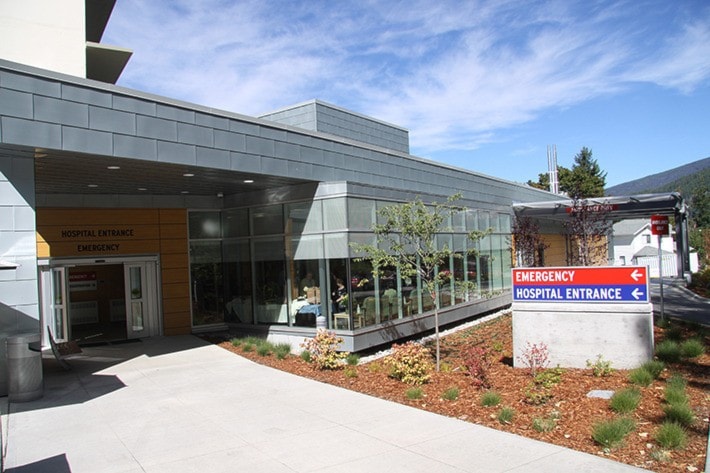Two months ago Nelson resident Rocco Mastrobuono was walking at Lakeside Park when he learned a friend had been diagnosed with breast cancer. To add to the bad news, the woman informed him she would have to travel to Trail for medical treatment.
Interior Health announced earlier this year that mammography equipment at the Kootenay Lake Hospital will not be replaced and secondary screening will no longer be available at the Nelson hospital as of April 30. Women will have access to initial mammogram screenings locally through the mobile unit approximately two to four times per year, including a visit this week.
This means any secondary screening and ongoing follow up required by breast cancer patients will require travelling to Kootenay Boundary Regional Hospital in Trail.
Many residents have voiced their concerns about the added travel time, especially for seniors and residents north of Nelson. Windy winter roads and lost wages to take time off work may further deter women from accessing a prompt diagnosis, they suggest.
Cancer survivor Mary Walters wrote to the Star to share her concerns with the decision, and took issue with the notion it will only affect some women. “Many women will not go to Trail due to distance, lack of transportation, winter driving conditions, travel costs and loss of wages and the waiting list,” she wrote.
Mayor Deb Kozak said she has discussed issues around transportation, transparency and the decision-making process with Interior Health since February and will continue to.
Rocco Mastrobuono. Photo by T. Hynd
 Mastrobuono has helped raise money for the hospital foundation, including a piece of ancillary equipment for the mammography unit. He's trying to get people together to challenge Interior Health to reverse its position. He also suggested the community might be willing to raise money for a replacement machine if the health authority gave the green light.
Mastrobuono has helped raise money for the hospital foundation, including a piece of ancillary equipment for the mammography unit. He's trying to get people together to challenge Interior Health to reverse its position. He also suggested the community might be willing to raise money for a replacement machine if the health authority gave the green light.
“I would like the mammography equipment to be replaced by Interior Health and not eliminated in whichever way possible,” he said. “I would like to wake up the consciousness of the community. Stop the bleeding of our hospital.”
Mastrobuono said it’s a trend that began in the 1980s and hastened in 2002 following the creation of the health authority.
“We lost lost the orthopedic surgeons, then urologist specialists. IHA is chipping away slowly. So what’s next, shut the hospital down?
“Piece by piece the Nelson hospital is being dismantled. We need to wise up: we’re going to wind up an emergency service.”
He doesn’t blame Trail though.
“They’re doing what’s good for Trail and we’ve been nice for too long,” he said. “If this happened in Trail, we’d have nothing less than a civil war.”
Anyone interested in forming a group for an action plan can contact Mastrobuono at 250-505-4563.
HEALTH AUTHORITY DEFENDS DECISION
Thalia Vesterback said the health authority made the “difficult decision” not to replace the Nelson mammography machine in part due to decreasing numbers of diagnostic mammograms being performed in Kootenay Lake Hospital as many were being done through the mobile van which comes to Nelson, Kaslo, Balfour, Crawford Bay, New Denver and Slocan. She added the van will be converted to digital mammography over the next year.
Digital mammography equipment purchased and installed at the Kootenay Boundary Regional Hospital in 2013. Photo courtesy of Interior Health
 Vesterback explained in a written statement to the Star why the digital machine was placed in the regional hospital in Trail rather than in Nelson: “More diagnostic mammograms are performed at that site (approximately double and closer to triple this fiscal year), and the machine there supports the regional breast surgical program.”
Vesterback explained in a written statement to the Star why the digital machine was placed in the regional hospital in Trail rather than in Nelson: “More diagnostic mammograms are performed at that site (approximately double and closer to triple this fiscal year), and the machine there supports the regional breast surgical program.”
She added that as the number of mammograms decreased at Kootenay Lake Hospital, it was difficult to meet new federal safety code regulations and standards regarding radiation protection and exam requirements for technologists and radiologists.
“Concentrating diagnostic mammography in Trail will allow us to meet these requirements moving forward,” she wrote, adding more exams can be performed per hour with the digital equipment, so wait times for diagnostic mammography will not change.
Interior Health has heard concerns from the community.
“We realize this requires Nelson and area patients requiring a diagnostic mammogram to travel to Trail and apologize for the difficulties this may create.”
Interior Health does not oversee public transportation, but Vesterback said they financially support the local Health Connections bus as well as the West Kootenay volunteer driver program through Castlegar and District Community Services Society, which has drivers in Nelson.
“Our diagnostic imaging department will work with Nelson patients so their appointments in Trail work with the bus schedule or timing of other transportation they are using,” she wrote.
Vesterback said some services are better located at the regional hospital if they require other supports that the regional hospital has in place.
“Some services like the regional ophthalmology services — such as cataract surgery and treatment for wet acquired macular degeneration — are provided at Kootenay Lake Hospital to take advantage of visiting eye specialists and the equipment available at the Nelson site. Regional bone density testing (primarily an imaging service for women who are at greater risk of osteoporosis) for the Kootenay Boundary is also based in Nelson.”
Kootenay Boundary Regional Hospital in Trail. Photo courtesy of Trail Daily Times

